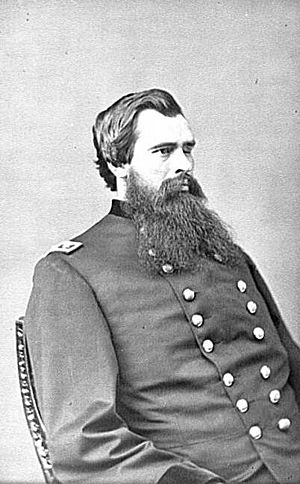Newton Martin Curtis facts for kids
Quick facts for kids
Newton Martin Curtis
|
|
|---|---|
 |
|
| Chairman of the United States House Committee on the Election of the President, Vice President and Representatives in Congress | |
| In office 1895–1897 |
|
| Member of the U.S. House of Representatives from New York's 22nd district |
|
| In office November 3, 1891 – March 3, 1897 |
|
| Preceded by | Leslie W. Russell |
| Succeeded by | Lucius Littauer |
| New York State Assembly (St. Lawrence Co., 1st D.) | |
| In office 1884–1890 |
|
| Personal details | |
| Born | May 21, 1835 De Peyster, New York |
| Died | January 8, 1910 (aged 74) New York City, New York |
| Political party | Republican |
| Military service | |
| Allegiance | United States of America Union |
| Branch/service | United States Army Union Army |
| Years of service | 1861–1866 |
| Rank | |
| Unit | 16th New York Infantry |
| Commands | 142nd New York Volunteer Infantry 1st Brigade, 2nd Division, X Corps |
| Battles/wars | American Civil War |
| Awards | |
Newton Martin Curtis (May 21, 1835 – January 8, 1910) was a brave officer in the Union Army during the American Civil War. He later became a member of the United States House of Representatives, representing New York State.
Contents
Early Life and Education
Newton Martin Curtis was born on May 21, 1835, in De Peyster, New York. He attended the Gouverneur Wesleyan Seminary. After finishing school, he worked as a teacher, a lawyer, and even the postmaster in his hometown. Before the Civil War began, he was a farmer.
Curtis was a very tall man for his time, standing 6 feet 7 inches tall and weighing 225 pounds. His height was so noticeable that President Abraham Lincoln once joked, "Mr. Curtis, how do you know when your feet are cold?" His family worried that his height would make him an easy target during battles.
Military Service in the Civil War
Joining the Union Army
On May 15, 1861, Newton Martin Curtis joined the Union Army as a captain. He was part of Company G in the 16th New York Infantry. He fought in the Peninsula Campaign and was injured in a small battle at West Point, Virginia.
On October 23, 1862, he moved to the 142nd New York Volunteer Infantry. He served as a lieutenant colonel before being promoted to colonel on January 21, 1865.
Key Battles and Promotions
As the commander of the 142nd New York Infantry, Curtis fought in the Bermuda Hundred Campaign in May 1864. He then took charge of the 1st Brigade, 2nd Division, X Corps, during the Siege of Petersburg.
Curtis was recognized for his bravery at the Battle of New Market Heights. He received a special promotion to brigadier general on October 28, 1864.
The Attack on Fort Fisher
His brigade was part of the mission against Fort Fisher in December 1864. Curtis's troops were among the few who landed ashore, but the first attack failed.
He participated in the second attack in January 1865. His brigade played a very important role in the Union victory. During the intense fighting, someone suggested they dig trenches. Curtis famously grabbed shovels and threw them over a defensive wall, shouting, "Dig Johnnies! I'm coming for you!" He kept his promise and led the charge.
Curtis was wounded while leading his brigade. For his courage, he was fully promoted to brigadier general of volunteers. He also received the Medal of Honor, one of the highest military awards. He stayed in the army until January 1866. On March 13, 1865, he received another special promotion to major general of volunteers.
Political Career and Public Service
After the Civil War, Curtis continued to serve his country in different ways.
- In 1866, he worked as a collector of customs in Oswegatchie, New York. This meant he helped collect taxes on goods coming into the country.
- From 1867 to 1880, he was a Special Agent for the U.S. Treasury Department.
- He worked for the Department of Justice from 1880 to 1882.
Serving in the New York State Assembly
Curtis was a member of the New York State Assembly for St. Lawrence County (1st District) for many years. He served from 1884 to 1890.
Member of Congress
As a Republican, Curtis was elected to the United States House of Representatives. He filled a spot that opened up when Leslie W. Russell resigned. He was re-elected two more times, serving from November 3, 1891, to March 3, 1897.
During his time in Congress, he was the Chairman of the House Committee on the Election of the President, Vice President and Representatives in Congress. This committee dealt with important rules about how presidents and other officials are elected.
Later Life and Legacy
In 1906, Newton Martin Curtis wrote a book called From Bull Run to Chancellorsville. It was about his experiences during the Civil War. In 1910, he worked as an assistant inspector general for the National Home for Disabled Volunteer Soldiers. This organization helped soldiers who were injured or sick after serving.
Newton Martin Curtis passed away on January 8, 1910, in New York City. He is buried at Ogdensburg Cemetery in Ogdensburg, New York. A statue stands there in his honor.
The General Newton Martin Curtis Camp #142 of the Sons of Union Veterans of the Civil War was named after him. This group helps remember and honor the soldiers who fought for the Union.

